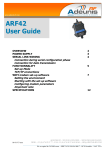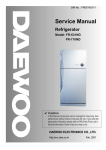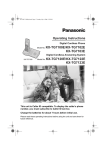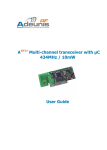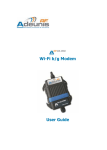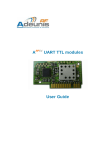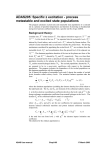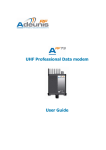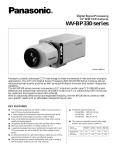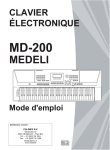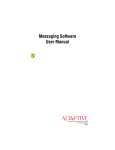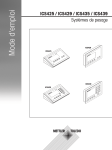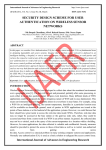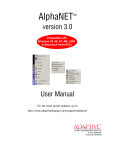Download ARF35 User Guide
Transcript
ARF35 User Guide PRESENTATION PRODUCT POWER SUPPLY SERIAL LINK WIRING MODEM / DTE RS232 DCE RS232 RS485 wiring RS485 interface activation 5 5 5 6 Communication channels RSSI reading 7 7 Addressed mode Serial commands Set of commands Description of the registers Configuration of the serial interface MODBUS compatibility Sending a serial command using HYPERTERMINAL 8 8 9 9 12 13 13 RADIO COMMUNICATION WORKING MODE SPECIFICATIONS ANNEX 1 - Firmware updates 06-06-V6-smn 3 4 5 7 8 14 15 ADEUNIS RF – 283 RUE LOUIS NEEL – 38920 CROLLES FRANCE DESK : +33 (0) 4 76 92 07 77 – FAX +33 (0) 4 76 08 97 46 E.MAIL : [email protected] ________________________________________________________________________________________ p1 SA au capital de 345.000 euros – SIRET 430 190 496 00017 – RCS Grenoble – NAF 322A DECLARATION OF CONFORMITY according to ISO/IEC Guide 22 and EN45014 Manufacturer’s name: ADEUNIS R.F. Manufacturer’s addressParc technologique PRE ROUX IV 283 rue Paul Louis NEEL 38920 CROLLES - FRANCE declares that the product Product Name: Product Number(s): Product options: ARF35 ARF7120C / ARF7120D / ARF7120E / ARF7120F conforms to the RTTE Directive 99/5/EC: EMC: conformity is proven by compliance to the standard EN 301489 according to the requirements of EMC Directive 89/336/EEC. Safety: conformity to the standard EN 60950 according to the requirements of Low Voltage Directive 73/23/EEC. Radio: conformity is proven by compliance to harmonised standard EN 300220 covering essential radio requirements of the RTTE directive. Notes: - Conformity has been evaluated according to the procedure described in Annex III of the RTTE directive. - The use of the spectrum is harmonised by the fact that the product never falls in one of the restrictions listed in appendix 3 (Annex 1, band E) of the CEPT recommendation 70-03. - Receiver class (if applicable): 2. Crolles, December 3rd, 2004 VINCENT Hervé / Quality manager 06-06-V6-smn p2 PRESENTATION The modem converts data from a serial link into a radio frame to be sent to a similar piece of equipment. radio transmission Serial link RS232 / RS485 The operating parameters of these modems (serial link, radio management….) can be modified through commands on the serial link. The products are available either in card version to be integrated in an assembly or as an IP65 chip with integrated or external antenna (RG58C cable + TNC connector). 06-06-V6-smn p3 PRODUCT POWER SUPPLY To perform wiring of these products, the bottom part of the housing (part with stuffing box) has to be opened by unscrewing the two stainless steel screws on each side. Retirer les visthese de la partie Remove screws avec presse étoupe + INHIB The ARF35 range products are supplied from a DC voltage source. This voltage source must be 8V minimum and must not exceed 30 VDC. - RTS RX TX CTS TX+ TX- RX+ RX- TX RX ON + DC Supply. The INHIB input MUST be connected to +V for turning ON the modem Î The INHIB input must be used to turn ON or OFF the modem according to the following table 06-06-V6-smn IN HI B Modem power supply GN D OFF unc onn ecte d OFF +V (832v ) ON p4 SERIAL LINK WIRING • MODEM / DTE RS232 This is for example the case of a modem connected to a PC N° / SUB-D 9 NOM + + Vcc IN H IB 5 G ND RTS 2 RXD 3 T XD RX TX C TS TX+ TXRX+ TX RX • RX- DCE RS232 This is for example the case of a modem connected to a measuring device. N ° / SUB -D 9 NOM + Vcc + IN H IB 5 GND RTS 3 2 RXD T XD RX TX C TS TX+ TXRX+ TX RX • RX- RS485 wiring RS485 Network B’ / Z Z / TX- T T A’ / Y 100 Ω Rt Y / TX+ Jumper B B / RX- R R A A / RX+ MODEM Network termination 485 The RS485 link needs to be adapted (each side). The modem includes a 100Ω termination resistor: • Jumper mounted, the resistor is connected between A and B (respectively RX+ and RX-) • No jumper, the resistor is not connected between A and B If the modem is ending the RS485 bus, the jumper must be mounted. The RS485 bus wiring needs only two wires for the PCB revision B (ARF7120/B) or greater. For the PCB revision A (ARF7120/A), the TX+ (respectively TX-) and RX+ (respectively RX-) MUST be connected together by the USER. PCB revision B or greater NAM E + Vcc GND ARF7120/B BUS RS485 + INH IB RTS A TX+/RX+ RX TX B TX-/ RX- Connect only TX+ or RX+ (note 1) CTS TX+ TX- TX RX Connect only TXor RX- (note 1) RX+ RX- jumper Note 1: ¾ TX- is connected to RX- on the PCB ¾ TX+ is connected to RX+ on the PCB Figure 1: RS485 wiring, PCB marked ARF7120/B or greater 06-06-V6-smn p5 PCB revision A NAM E + Vcc GND ARF7120/A BUS RS485 + INH IB RTS A TX+ et RX+ RX TX- et RX- CTS TX+ and RX+ connected together by the USER TX B TX+ TXRX+ TX RX TX- and RXconnected together by the USER RX- jumper Figure 2: RS485 wiring, PCB marked ARF7120/A The wiring could be checked by sending the SLI command using a terminal (see serial command). If the link is properly configured, the modem register values are sent back by the modem to the terminal (if not try to reverse the RS485 bus polarity Î reverse RX+/TX+ with RX-/TX- connection). • RS485 interface activation When delivered the product is configured in RS232 Î for ACTIVATING the RS485 interface, please refer to chapt. Configuration of the serial interface WARNING: when using the RS485 interface, the minimum time for switching from RS485 transmission to RS485 reception is 4 ms, 20 ms for baudrate 600 and 1200bps. ARF 35 RS485 link QUERY data bytes ANSWER data bytes 06-06-V6-smn PC or PLC The delay between the LAST byte of the query and the first byte of the answer MUST BE GREATER than 4 ms p6 RADIO COMMUNICATION • Communication channels This modem has 2 or 5 channels that could be selected through commands C h a n n e l S 2 0 0 0 1 2 3 4 • 2-channel version Frequency (Radio data rate 34800 kbit/s) 5-channel version Frequency (Radio data rate 9600 kbit/s) 869.4625 MHz 869.5875 MHz 869.425 MHz 869.475 MHz 869.525 MHz 869.575 MHz 869.625 MHz RSSI reading The RSSI (Received Strength Signal Indicator) gives an indication for the received power level. Power level Notes: • The RSSI level is only an indicator. Use this level with care due to the dispersion between components. • The schema above could be modified from one to another product. The Operating temperature could also have an impact on these dispersions. • The RSSI level could also indicate the potential presence of jammer in the used channel. • The RSSI is a necessary but not sufficient condition to obtain a correct reception. 06-06-V6-smn p7 WORKING MODE Half duplex transmission This modem has 2 working modes: ¾ Transparent mode, without flow control. When transmitting, data received from the serial link are transmitted on the radio link. When data are received on the radio link, these data are sent on the serial link. ¾ Addressed mode, with flow control (see register S216) • • In these modes, the frame transmission always start on the following conditions: Detection of a silence on the serial link, greater than S217, after the reception of the latest character. Or when the number of received characters from the serial link is greater or equal to the maximum radio frame size (S218). • Addressed mode • In transmission mode, data received on the serial link are sent on the radio link with the following format: Frame format: <preamble><synchro><Address> DATA <postambule>. Preamble, synchronisation and postambule are used for the radio reception. The Address field is set up with S256 (destination address) value (LSB first). • • In reception mode: The <Address> field of the radio frame is checked with the local address (S252) If the addresses match, DATA (and only DATA) are transmitted on the serial link, otherwise received data are silently discarded. • Serial commands ¾ ¾ ¾ They are used to configure the modem parameters or read the modem set-up. They are sent during the modem mode. They aren’t sent on the radio link. A SLSTRING is interpreted as a command only if a silence is present before (see <silenced>) the SLSTRING and after (see <silencef>) the SLSTRING. Otherwise the string is not interpreted as a command, and therefore it is sent on the radio link. • Serial Command format: <silenced>SLSTRING<silencef> with <silenced>: silence before the command, more than 3 characters (see S214). SLSTRING, serial command, always starting with the characters SL. (Example SLI for displaying modem registers) <silencef> : end silence, more than 3 characters (see S214) • • • The answer to a SL command could be: the string OK Î command executed successfully The string ERROR (syntax error, unknown command…) a specific string according to the requested information • • Sending a serial command using a terminal: see chapt. Sending a serial command using HYPERTERMINAL 06-06-V6-smn p8 • Set of commands Commands Description SL#I=xxxx Program all the addresses (TX/ RX) with value xxxx = hexadecimal address (0000... FFFF) Display the reception level of the latest received message. Response: -xxx dBm with xxx decimal value SL@R? Note The RSSI values are between –115 and –60 dBm. SL**> SL%V? Save the current configuration in EEPROM. Each time you switch on the modem, the EEPROM configuration will be loaded in the modem registers. Display the software version (response Vn.nn) SLSn? Reading the value of register n SLSn=m Initialise the register n with the value m (m=0000….FFFF) SLR SLTn All the registers are initialised with their default value auto-test mode (n = test number) SLT1 = carrier emission, TX data = 0 SLT2 = carrier emission, TX data = 1 SLT3 = 19200 kHz modulation (38400 bauds) SLT4 = 1 kHz modulation (2000 bauds) Test mode exit : by updating the working mode (SLS220=x) Display all the registers values SLI 1 Note 1: During SLTn command transmission, the new working mode (S220 register) is stored in E2PROM Î The modem will run again in auto-test mode at each power up. To leave the auto-test mode, you have to modify the S220 register and save the parameters. • Description of the registers The parameters of the modems could be updated through the SLS commands and save in EEPROM. When upgrading a register value, the value is updated in RAM. You must use the SL**> command to save the parameters in EEPROM. In case of parameters lost, the default values are restored. Access R/W Register S200 Function Channel number Description Radio control Communication channel. Value between ‘0’ and ‘4’. Default value: ‘0’ Note 2-channel version 0 Æ 869.4625 MHz, 1 Æ 869.5875 MHz 5-channel version 0 Æ 869.425 MHz, 1 Æ 869.475 MHz, 2 Æ 869.525 MHz, 3 Æ 869.575 MHz, 4 Æ 869.625 MHz R/W S218 Radio frame size Maximum size of the radio frame data. When this size is reached, the CTS signal is activated. From 50 up to 240. Default value: 128 R S230 RSSI value Read of the RSSI signal value (read on the ADC converter, hexadecimal value) Serial link control 06-06-V6-smn p9 R/W S210 Baud rate Serial data rate ‘0’ : 600 bits/s ‘1’ : 1 200 bits/s ‘2’ : 2 400 bits/s ‘3’ : 4 800 bits/s ‘4’ : 9 600 bits/s (Default value) ‘5’ : 19 200 bits/s ‘6’ : 38 400 bits/s R/W S211 Number of bits ‘7’ : 7 bits ‘8’ : 8 bits (Default value) R/W S212 Parity ‘1’ : none (Default value) ‘2’ : even ‘3’ : odd R/W S213 Number of stop bits ‘1’ : 1 stop bit (Default value) ‘2’ : 2 stop bits ‘3’ : 3 stop bits 2 R/W S214 Time out Serial link Time out to detect a command (units 1 ms). Value from 3 up to 240. Default value: ‘3’ (3 ms = 3 characters at 9600 bauds) 1 R/W S215 Interface type ‘0’ : RS232 (Default value) ‘1’ : RS485 half duplex 3 R/W S216 Flow Control ‘0’ : hardware (RTS/CTS) ‘2’ : none, default value R/W S217 Start transmission Time Serial link Time out to start the radio transmission (units 1 out 1 ms). Value from 3 up to 240. Only one value: ‘3’ (3 ms = 3 characters at 9600 bauds) R/W S220 Working mode R/W S252 Local Address 1, 4 Working type ‘1’= transparent mode ‘6’= addressed (default value) from ‘11’ up to ‘14’ Î auto-test Network control (addressed mode only) 2 bytes value, from 0 to FFFF In addressed mode, allow filtering the incoming radio frame (all frame with an <address> field different from this local address are silently discarded) R/W S256 Destination Address 2 bytes value, from 0 to FFFF In addressed mode, the <address> field of a radio frame is filled with this destination address) Note 1: when a serial speed change is requested, the S214 and S217 register values are automatically set to a value greater or equal to the duration of three characters in the requested speed (13 ms for 2400 bauds, 7 ms for 4800, 3 ms otherwise). Note 2: 3 stop bits are only usable with 8 bits of data. With 7 bits of data and 3 stop bits, the serial format used is 7 bits of data and 1 stop bit. Note 3: When changing the interface type (example: RS232 to RS485), the response is sent before the interface updates (in our example on the RS232 link); the following serial communications must be done on the new interface (in our example, on the RS485 link). 06-06-V6-smn p10 As a reminder: the parameters are saved with the SL**> command. Note 4: If the flow control is not used, the serial data rate must be coherent with the radio rate. For example, with the 5-channel version the radio rate is 10 kbit/s: a serial rate of 9600 must be used without flow control, while using a serial rate of 19200 will produce data overrun (radio reception buffer) 06-06-V6-smn p11 Configuration of the serial interface The choice between the RS232 or 485/422 interface depends of the S215 register value. There is two ways for activating the RS485 mode: ¾ Software mode (updating the S215 value using a command) ¾ Hardware mode (forcing default parameters) Serial interface switching, software mode For switching from RS232 to RS485 interface: Step 1. Connect both RS232 and RS485 interface to your modem Step 2. Using the RS232 serial link, send the serial command SLS215=1 Step 3. Now the RS485 interface is activated; (Using the RS485 link send the SLI command for checking the RS485 activation) Step 4. Using the RS485 interface send the SL**> command for saving the S215 register value. Now at next start-up, the product will work with the RS485 interface For switching from RS485 to RS232 interface: Step 1. Connect both RS232 and RS485 interface to your modem Step 2. Using the RS485 serial link, send the serial command SLS215=0 Step 3. Now the RS232 interface is activated; (Using the RS232 link send the SLI command for checking the RS232 activation) Step 4. Using the RS232 interface Send the SL**> for saving the S215 register value. Now at next start-up, the product will work with the RS232 interface Serial interface switching, Hardware mode The kind of interface can be updated when the modem is powered up: the configuration switches (#2 and 4) allow choosing a requested configuration. ¾ WARNING: when using these switches the new configuration is saved in EEPROM Hardware switch to RS232 interface: 1. Switch off the module 2. Put the switch 2 in position ON 3. Switch on the modem Î the green led is ON 4. Put the switch 2 in position OFF 5. The modem is ready to work with the RS232 interface (the serial parameters used in RS485 mode are preserved). Hardware switch to RS485 interface: 1. Switch off the module 2. Put the switch 4 in position ON 3. Switch on the modem Î the green led is ON 4. Put the switch 4 in position OFF 5. The modem is ready to work with the RS485 interface (the serial parameters used in RS232 mode are preserved). Hardware switch to restore factory settings for interface: 1. Switch off the module 2. Put the switch 2 and 4 in position ON 3. Switch on the modem Î the green led is ON 4. Put the switch 2 in position OFF 5. The modem is ready to work with the RS232 interface with the following serial settings: 9600 bauds, 8 bits, 1 stop and no parity. 06-06-V6-smn p12 • MODBUS compatibility The ARF35 is MODBUS RTU and ASCII compatible, if the following recommendation is fulfilled: the radio rate and the serial rate must be equivalent (this for avoiding a MODBUS packet splitting). ¾ With the 10 kbit version (radio rate) the serial speed must be 9 600 baud ¾ With the 40 kbit version (radio rate) the serial speed must be 38 400 baud • Sending a serial command using HYPERTERMINAL The serial command can be sent using a standard terminal. Hereafter an illustration is done with HyperTerminal and the SLI command. Step 1. First you must edit a text file and type the command you want to send (without any additional character): SLI. Step 2. When saved, check the length of the text file in its properties Î the size MUST be 3 for the SLI command Step 3. Open HyperTerminal, configure the serial parameter to 9600, 8 bits, 1 stop, no parity Step 4. Send the text file created in step 1 Step 5. The terminal must display all registers values. WARNING: When using a terminal in WINDOWS environment, the delay between characters is not guaranteed. Even if you are sending the command using a text file (as describe above) you can have some delay between the characters Î if so, the modem is not able to successfully retrieve the requested command. Try to use another terminal or another PC. 06-06-V6-smn p13 SPECIFICATIONS General technical characteristics • Operating temperature: -20 to +70 °C • Power supply: 8 to 30 Volts (integrated regulator) • Size: 145x100x40 mm + 85 mm antenna • Number of channels: 2 or 5 • Modulation: FSK • Packaging: IP65 box with integrated or external antenna Transmission • Programmable frequencies: 869,4625 and 869,5875 MHz (2-channel version) 869,425 / 869,475 / 869,525 / 869,575 / 869,625 MHz (5-channel version) • Radiated RF power: 500 mW (+ 27 dBm) • Tx / Rx Consumption: 400 mA / 40 mA (under 8 Volts) Reception • Sensitivity: • Radio data rate: • RSSI: –100 dBm (2-channel version) –105 dBm (high sensitivity 5-channel version) 40 kbits/s (2-channel version) 10 kbits/s (high sensitivity 5-channel version) Available through serial commands Protocol • Serial data rate: from 2400 to 38400 bauds (programmable through serial commands • Serial ports: TxD, RxD, RTS. Standard configuration: RS232. The RS485 configuration is performed through serial commands. • Handshake: none or RTS/CTS • Configuration: through serial commands • Modes: transparent or addressed, full custom firmware on request • Standard compliance:EN 300-220 and EN 301-489 (full certified modem) • Range: 6 km in free field Alternative versions ARF 7120C: 2-channel RS232/RS485 modem IP 65 box with integrated antenna ARF 7120D: 5-channel RS232/RS485 modem IP 65 box with integrated antenna ARF 7120E: 2-channel RS232/RS485 modem IP 65 box with external antenna (RG58C cable + TNC connector) ARF 7120F: 5-channel RS232/RS485 modem IP 65 box with external antenna (RG58C cable + TNC connector) Version ARF 7120C 2 channels Radio data rate 40 kbits/s Receiver sensitivity -100 dBm Range(in free field) 4 km ARF 7120D 5 channels 10 kbits/s -105 dBm 6 km ARF 7120E 2 channels 40 kbits/s -100 dBm 4 km ARF 7120F 5 channels 10 kbits/s -105 dBm 6 km 06-06-V6-smn p14 ANNEX 1 : Firmware updates Firmware V1.06 /V10.06 Updates Add Baudrate 600 and 1200bps Increase RS485 buffer deactivation time (when the modem ends data transmission to equipment) for baudrate 2400 and 4800bps. Add the delay for 600 and 1200bps baudrates. Increase RS485 buffer deactivation time for command mode to be able to work properly to every baudrate. Change SW1 and SW2 management: When SW1 or SW2 is set, serial parameters are not changed. When SW1 and SW2 are set, serial parameters are backed to 9600, n,8,1 and the RS232 interface is activated. Correct the bug of invalid switch sampling at startup. 06-06-V6-smn p15















